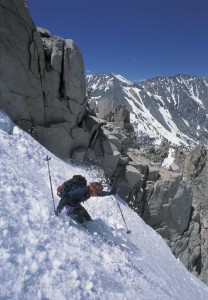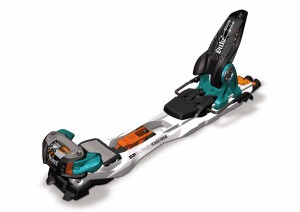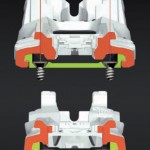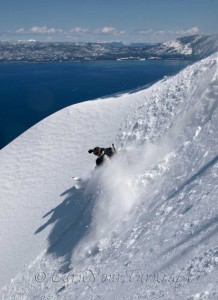While some thought the lack of numbers in the backcountry was due to a fear of the dangers there, the Duke made clear, danger is part of the lure. Marker simply provided the requisite ingredients that alpine skiers could and would believe in to chase untracked lines.
So far, only Duke has a track record proving it can rock as hard as you can in-bounds, as hard as you dare out-of-bounds, and can help you climb back for another run as easy as pie. Users are adamant and consistent in their endorsement of how well the Duke skis compared to any other touring binding, and until this year, there was really no serious competition for its reputation.
With the advent of competition from Tyrolia and Salomon it is clear skiers have voted resoundingly with their wallets, yes, we want to ski anywhere and everywhere. We want a binding with beef on a plate, screw the weight.
Downhill Performance
In the binding you will be a full 36mm above the top of your ski. Not so good for sensitivity, but great for better leverage on hard snow. There is also a sliding AFD under the toe, and the height of the toe is easily adjustable to accommodate the variation possible with sole thickness in AT boots.
Tour Mode
Like any plate style AT binding touring performance is a compromise. Nonetheless it’s quite acceptable for short or sidecountry tours. Some folks bemoan the fact that you need to exit the binding to switch modes, but if you’re putting skins on, you need to be off your skis anyway. If you’re wearing fat skins you might need to step out to take them off which just creates an opportune time to make sure the tracks on the rear slider are clear of ice. Though tech bindings may tour better, the Duke tours fine enough and far better than what most pinheads put up with in the 90s.
While the Duke is known to ice up, even regularly, it rarely becomes an unmanageable mess. The locking baseplate is plastic which helps reduce icing, and when snow does pack underneath the rails it is easily cleaned out so you can lock the heel for turns. Usually you just need to slam the binding closed a few times and, voila’, you’re ready to charge back down.
The climbing post resides under the heel, not optimal but it can be flipped into position, with a bit of practice, using your ski pole. Marker also calls attention to the fact that the binding shifts aft 40 mm when in tour mode claiming it tours better here. I’ll admit it can help the tip to float in soft snow or give better skinning purchase with the pivot more toward the rear but it definitely does not make kick turns easier as claimed. Since it is a free pivot it doesn’t hinder them much either, but a more centered pivot position, as well as one that is under the toe, not in front of it, is superior. The Duke has neither of those traits. It’s a small demerit and only worth pointing out to correct bogus marketing spin.A big part of the weight with the Duke comes from a super heavy duty, 16 DIN spring. It sounds like overkill to seasoned backcountry skiers, but to those taking as much air as they dare, having a range of elasticity up to 16 DIN sings with the sweet sound of assurance at every landing. That’s also why it is so solid in the bumps, or wherever it is that you are compelled to crank it up.
As soon as you start going long, either on big days, or several consecutive days fully earning each turn, the weight will wear on you – especially if you’re breaking trail in deep snow. When you get to that stage know two things. First, you’re hooked, and two, you can chop weight without even adjusting your technique, all it takes is mo’ money (for a tech system).
Wobble, Wobble?
If you use the Duke to earn a lot of turns you may eventually notice slop in the main pivot and in the mode switch. It makes for a wobbly tour mode. One cure is to send it to Marker for warranty repair. Another might be to add bushings around the interface between the main pivot and the supporting plastic. If you use a Duke on enough tours that it wobbles out, you’re ready to graduate to a tech system.
Even if you do reach the stage where you want a lighter, more durable binding, most Duke riders keep their Dukes handy for days when they’re making tracks on both sides of the rope and keepin’ up with the boyz. That’s where you’ll appreciate the solid connection of the plate to your ski along a sliding rail.
Summary
With a binding like the Duke, the only reason not to go into the backcountry would be a lack of skiing skill, or safety. Both those conditions can be overcome with knowledge and experience. That means if you’re a hard core skier, some day you will at least flirt with the Duke. You might even take ’em for a spin and once you taste how sweet earning your turns is, the Duke will deliver plenty of fun filled adventure.
The Duke has one other bit of confidence inspiring value – a six year track record of largely satisfied customers. There may be other options to chose from in the heavyweight touring division this year, but no others with tens of thousands of testimonials.
Marker
Duke
Price: $495
Weight/pr: 6 lbs., 2 oz. (2.78 kg)
Sizes avail: Small (265mm < b.s.l. < 325mm), Large (305mm < b.s.l. < 365mm)
Brake widths: 90, 110, 130 mm
Baron
Price: $445
Weight/pr: 5 lbs., 6½ oz. (2.45 kg)
Sizes avail: Small (265mm < b.s.l. < 325mm), Large (305mm < b.s.l. < 365mm)
Brake widths: 90, 110, 130 mm
© 2012
[adrotate banner="35"]





14 pings
Skip to comment form
[…] In the plate binding world Marker migrates the Extended Power Frame from this year’s Duke down the line to the DIN13 Baron and even the lighter weight Tour F12. This is a much needed […]
[…] standard alpine boots to earn their turns with. In the interim Marker developed the still heavier Duke binding with release values up to DIN 16, followed by Salomon’s DIN 16 Guardian and […]
[…] Marker Duke […]
[…] consider the piece of mind an extra 4 pounds of plastic placebo provides (via Guardian, Tracker, Duke, Baron, or Adrenaline) instead. […]
[…] you lock it down again, the plate is held secure in a manner reminiscent of the Duke, eliminating the lateral play of a Guardian or […]
[…] Rossi, Look, Marker, or Head. Some skis were outfitted with AT bindings allowing me to ski the Marker Duke, Salomon’s Guardian, and the Tyrolia […]